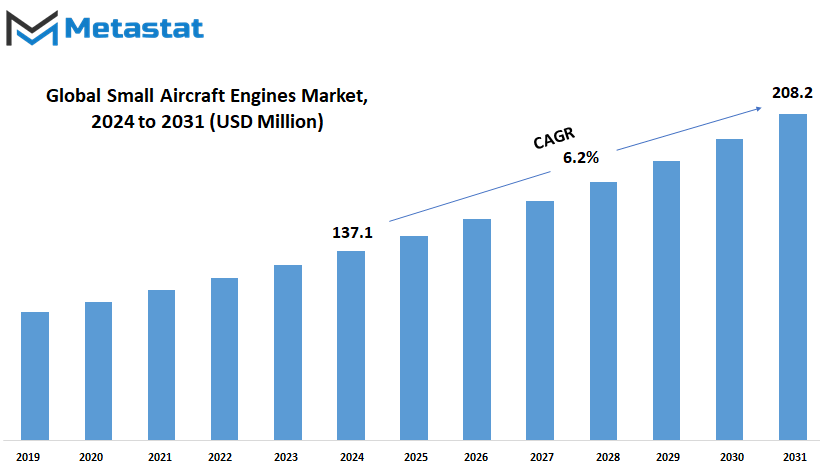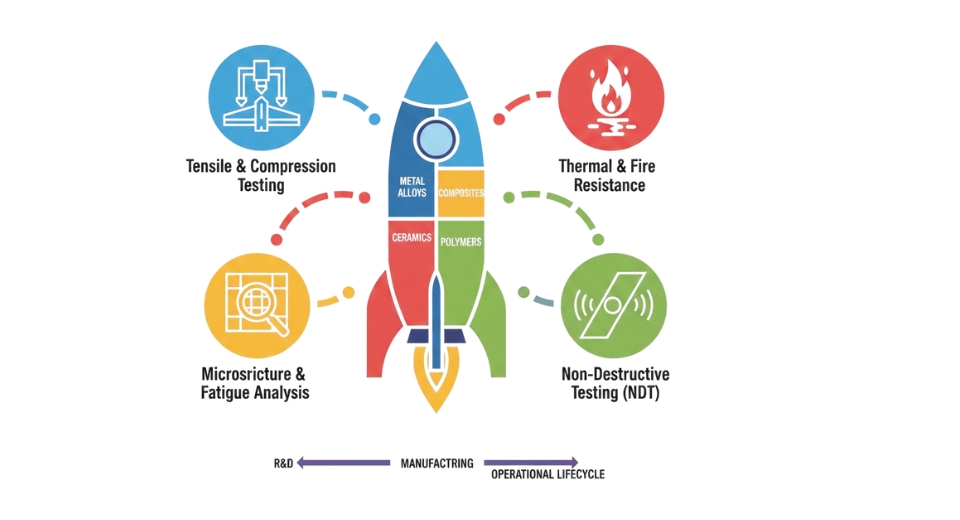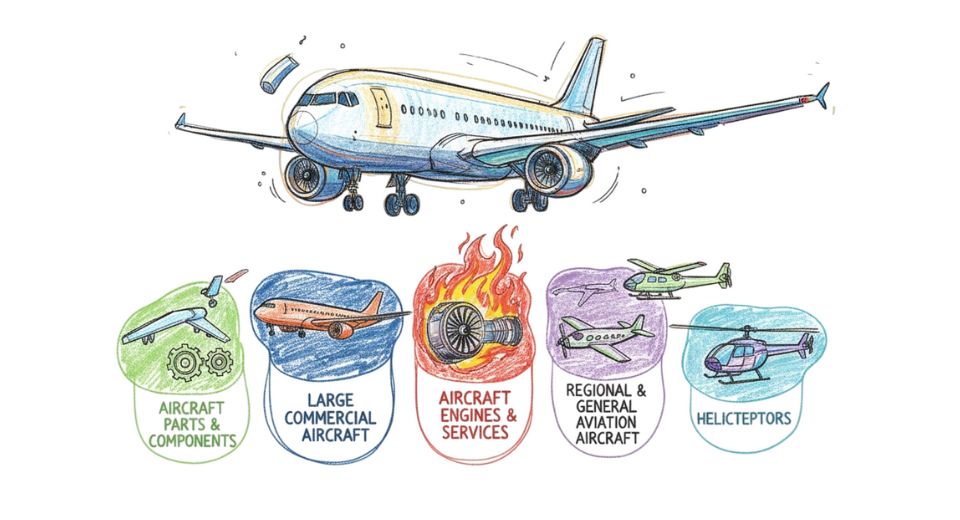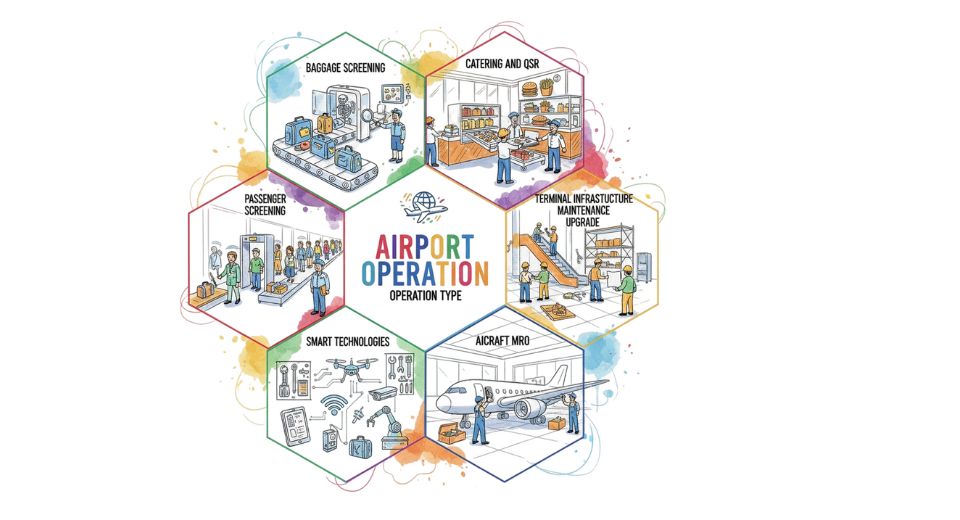MARKET OVERVIEW
The Global Small Aircraft Engines market is a niche segment of the aviation industry, with the development, manufacturing, and distribution of engines designed for lighter aircraft and those in private planes, light-sport aircraft, as well as unmanned aerial vehicles. This market, in total, serves various applications in the aviation realm, requiring compact, efficient, and reliable power solutions, mainly by private pilots, hobbyists, defense operations, and niche commercial applications. The demand for these engines is based on the changes in technology and the growing need for lightweight and fuel-efficient engines to fit ever-changing operational and environmental requirements.
This industry is unique, as it focuses much on innovation, while high-tech precision engineering is aimed at ensuring maximum performance and safety in small-scale aviation. Manufacturers in the global small aircraft engines market focus on a diverse range of engine configurations, including piston engines, turboprop engines, and electric propulsion systems. For each of these engines, the usage cases would vary, depending on maximum power output, weight, efficiency, and cost considerations. Piston engines enjoy dominance in personal aviation and training aircraft due to their reliability and cost-effectiveness. Turboprops are preferred for their superior performance in short-haul commercial flights. Electric propulsion is emerging as a transformative technology within this market, driven by the industry’s push toward sustainability.
The scope of the Global Small Aircraft Engines market is extensive, including not only the production of engines, but also numerous efforts for research and development to improve performance and meet very stringent aviation standards. Firms operating in this market invest considerably in innovation, exploring lightweight materials, hybrid systems, and advanced control mechanisms. These advancements promise to redefine efficiency and capabilities in small aircraft engines; they will influence many aspects of potential future aircraft designs and applications. Aftermarket services, such as maintenance, repair, and overhaul (MRO) operations, also play a key role in extending the lifecycle of the engines while ensuring safe operation.
The market is global and holds potential on all continents, with the largest markets in North America, Europe, and Asia-Pacific. Each region uniquely adds to the market landscape. For example, North America has a strong general aviation sector, driving demand for small aircraft engines, whereas Europe focuses on technological innovation and sustainability. Then there is Asia Pacific, representing a rapidly growing market, as investment in infrastructure and defense capabilities continues to increase. Global interconnectivity also drives this market, with the frameworks developed through regulatory regimes, free trade agreement, and international partnership dictating networks of production and distribution.
Looking ahead, the Global Small Aircraft Engines market will be transformed by changes in materials science and propulsion-related technologies as well as regulations on environmental issues. The use of digital solutions-facilitating predictive maintenance and real-time engine performance monitoring-will provide greater operational safety. With the alignment of the aviation industry with global sustainability goals, it can be expected that manufacturers in this market will lead the focus on further development of engines that emit less and operate more efficiently. These trends speak to the significant role played by the market in small-scale aviation in forecasting that future.
Global Small Aircraft Engines market is estimated to reach $208.2 Million by 2031; growing at a CAGR of 6.2% from 2024 to 2031.

GROWTH FACTORS
The Global Small Aircraft Engines market is growing multifold with various factors reflecting present day demands and future innovations. At the forefront of this growth is the renewed interest in general aviation and recreational flying. More people have been interested in enjoying the freedom and convenience provided by personal aircraft, thereby increasing the demand for small aircraft engines. This trend has also been supported by more pilot training programs and access to flying as a recreation activity by various regions.
Other important driving forces come in the area of technological advancements within the design of engines. High-fuel economy, reliability, and environmentally friendly modern small aircraft engines have all increased more for this market. These benefits not only reduce the costs of operation but also resonate with the global efforts to save the environment. As industries worldwide aim to minimize their carbon footprint, the development of engines that meet stringent emission standards without compromising performance is expected to gain momentum. Such advancements also enhance the appeal of small aircraft for both personal and commercial use.
Yet, problems exist in this space. Manufacturing and maintaining small aircraft engines remain expensive, so the issue of affordability is significant for those interested in buying a small aircraft engine. Besides, proper regulatory and certification requirements on safety and emissions further complicate the development of this market. Even though they are paramount for security of its passengers and operators, at times, such standards may hinder innovativeness and lead to cost increases for manufacturing companies.
The Global Small Aircraft Engines market does indeed offer promising opportunities, most especially with interest in electric and hybrid propulsion systems. Such emerging technologies are likely to change the game of this market by offering cleaner and cost-effective alternatives. Electric and hybrid engines serve to address environmental but also open new possibilities for quieter and more efficient aircraft. This segment will grow with the continued investments of governments and private companies in sustainable aviation technologies, offering lucrative opportunities for manufacturers and suppliers.
Over time, demand for the market is expected to grow as traditional combustion engine demand is balanced against innovative propulsion systems. With ever-easier access to recreational flying, coupled with continued technological changes in aviation, the industry will be sure to experience a rub-off of increased demand in the support of successes in bracing cost and regulatory hindrances. The evolving preferences of consumers and businesses alike ensure the Global Small Aircraft Engines market remains a dynamic and promising sector in the aviation industry.
MARKET SEGMENTATION
By Engine Type
The Global Small Aircraft Engines market is a part of the aviation industry and plays a significant role in the growth pattern. We can see several improvements in this market over the coming years due to technological innovation, sustainability, and increasing demand for better aviation solutions. Small aircraft engines are crucial parts responsible for powering various aircraft for flying privately, commercially, and by the military.
Looking forward, the Global Small Aircraft Engines market will continue to diversify, with several key engine types playing a big role in its further development. These include piston engines, turboprop engines, jet engines, and rotary engines. Each of these types will contribute to the market, catering to different needs and preferences in aviation.
Piston engines are probably going to remain as a main player in the market, especially for the small, more modest aircraft. The piston engine is known for its reliability and relatively lower cost. Light aircraft use this kind of engine, and people can look forward to piston engines being more efficient in the future-as their designs improve and they begin to emit less, achieving better fuel consumption rates.
Another area that is expected to grow in the upcoming years is the turboprop engine used in regional aircraft. These engines are, in general, very well known for their performance at different conditions, giving out a kind of balance between power and fuel efficiency. With airlines opting to continue smaller aircraft for regional or shorter flights, these machines are going to be even more important in the future. Future developments may focus on reducing noise and enhancing overall performance, ensuring that these engines remain competitive in a rapidly evolving market.
Notably, though, since jet engines are currently employed in most large aircraft, significant industry activity is expected in the small aircraft space also. As technology continues to advance, manufacturers would focus on developing smaller, more efficient jet engines that can attain greater speeds and higher fuel efficiencies. This trend will be achieved due to the increasing demand for faster travel and for jet-powered aircraft that can service airports lacking the infrastructure.
Lastly, there are rotary engines, not as common but very efficient; they will continue to have their uses in specific applications, like helicopters and experimental aircraft, taking advantage of their inherent characteristics of delivering smooth and consistent power, which will push further the frontiers of their applications in different sectors of aviation.
The engines hence are going to shape this future of Global Small Aircraft Engines in various advantages that each comprises. As the technology advances, the environment-friendliness, reliability, and efficiency of these engines grow, and with such a need in the aviation world, it keeps on rising. It might be improved variants of the existing engines or new unarticulated technologies; whatever it is, the market is going to be dynamic and diverse in the coming years.
By Fuel Type
The Global Small Aircraft Engines market is on the cusp of massive growth in the following years. This market deals with the small aircraft engines that form the core product of this sector in light aviation, training, and air taxi services. The market is expected to boom as technological advancements continue to characterize this industry, promising significant development with several critical developments in fuel types that will alter the small aircraft paradigm.
Segmentation is presently done in the market by type of fuel, including Avgas (Aviation Gasoline), Jet A/A-1 (Kerosene-based Jet Fuel), Biofuel, and others. However, each has different characteristics and operates at different levels of the aviation chain.
Avgas or aviation gasoline remains the most common fuel for small aircraft. It is a popular choice for general aviation aircraft, generally piston-engine planes. Moving forward, the future of Avgas in the Global Small Aircraft Engines market will largely depend upon the continued demand for traditional and smaller aircraft. Though environmental impact as well as fuel efficiency may put pressure on the industry towards a more sustainable alternative.
Jet A/A-1 is a kerosene-based jet fuel, but is basically found in turbine engines and, thus, used in small jets. Although this fuel is primarily used in commercial aviation, its application in small aircraft is increasingly growing due to the widespread affordability and efficiency of turbines. It would appear that the growing trend toward higher fuel efficiency and less emission engines would suggest greater use of Jet A/A-1 in the future, perhaps more so for small business jets and high-performance aircraft.
Biofuels is one of the rapidly developing areas within the Global Small Aircraft Engines market, due to escalating environmental considerations. Biofuels are based on renewable raw materials such as plant oils, algae, and waste products. They would very likely provide a promising path toward reducing carbon emissions for aviation; thus, as technology evolves, so will biofuels availability for use in small aircraft engines. Perhaps in the future, the role of biofuels will include even more significant contributions in advancing away from fossil fuels.
Other fuel types are also explored, including synthetic fuels and hydrogen. Alternatively, these types of alternative fuels could be important to the aviation industry in its quest toward moving toward more sustainable operations. Innovations in fuel technology will likely make it possible to reduce emissions and improve engine efficiency, allowing the global small aircraft engines market to meet the requirements for even environmental goals moving into the future.
Looking ahead, competition among these fuel types in the market for small aircraft engines is likely to increase. The decision on which one to use will be a culmination of performance factors and regulatory push for sustainability. Consequently, the global small aircraft engines market fuel landscape will change and provide options that meet the requirements of the aviation industry and considerations towards the environment.
By Aircraft Type
The Global Small Aircraft Engines market is expected to continue growing steadily over the next few years. This market is driven by the increased demand for efficient, cost-effective propulsion systems for smaller aircraft. As the aviation industry continues to evolve, smaller aircraft are becoming increasingly popular, especially for private, regional, and business travel. This trend is going to expand the market and, subsequently, the variety and niche this could give manufacturers in small aircraft engines an opportunity to innovate and meet different customer needs.
The Global Small Aircraft Engines market is further segmented by aircraft type, and each of these aircraft types presents immense growth opportunities. Such aircraft types included are Single Engine Aircraft, Multi-Engine Aircraft, Light Sport Aircraft, and Business Jets. Every aircraft type has different requirements regarding engines that leads to a niche sub-market for each.
Single Engine Aircraft are widely preferred for personal and recreational purposes due to their simplicity and lower costs. These engines are highly reliable in performance and require the least amount of maintenance. With growing demand for more affordable personal aviation, there is an increasing need for small, low-power single-engine aircraft. This will lead to an increase in the Global Small Aircraft Engines market because of the need for light, fuel-effective engines that fit the bill for these aircraft types.
Multi-engine aircraft, on the other hand, can be used for more complex operations and are mostly applied in commercial business. These aircraft need higher power and reliability engines. Due to increasing needs of machines capable of distance along with more passengers or cargo in aircraft, multi-engine aircraft become a dominant part of the small aircraft market. The engines will probably be optimized for power and efficiency, which are essential considerations in maintaining competitiveness as the airframe costs rise to reflect competitive market parameters.
Light Sport Aircraft are smaller, lighter variants of general aviation aircraft. These have been gaining popularity, more for recreational flying and flight training. Flight schools and private individuals often select LSA because the purchase price is relatively low. This segment is bound to continue growing; the Global Small Aircraft Engines market will see an increased need for lightweight yet fuel-efficient engines, which are also high in performance but in affordable prices.
Finally, Business Jets represent a premium segment within the Global Small Aircraft Engines market. These aircraft require engines with exceptional reliability, power, and efficiency, as they are often used for time-sensitive and long-distance travel. With the growing trend of private business travel, the demand for small, high-performance engines for business jets will continue to increase, offering opportunities for market growth.
In the event of the rising demand for smaller, more efficient aircraft engines, the Global Small Aircraft Engines market will be expected to witness significant technological improvements. Future engines will likely be more fuel-efficient, quieter, and eco-friendly, created according to the emerging requirements of the aviation industry and environmental concerns.
By Application
The world small aircraft engines market is the airline industry’s backbone and involves impact almost all sectors where aircraft transportation is the mode of travel, defence-related sectors, and specialized units. The market, in the ensuing years, will mushroom and play a defining role in shaping the future of the aviation industry through the supply of different types of aircraft with engines. These aircraft engines are used in a vast number of applications, and the understanding of these applications is well key to the forecasting of the market’s direction.
In the general aviation sector, small aircraft engines power various ranges of planes used for private, recreational, and business flying. For the most part, these are chosen for reliability, efficiency, and a relatively low cost, making them suitable for private pilots and small businesses. With ever-advancing technology, the demand for more fuel-efficient and environmentally friendly engines in general aviation will likely go up. This will positively drive growth within the global small aircraft engines market, as innovations are then available to a larger number of consumers, making flight travel more accessible.
Another significant subsegment is commercial aviation. While large commercial airlines make use mainly of larger-sized engines, small aircraft play a significant role in regional and commuter flights. Many cities are becoming increasingly interlinked as greater diversity becomes available in air travel, which requires more demand for small aircraft engines to power smaller planes used for short regional flights. These engines are expected to evolve to meet increasing demand for efficiency and sustainability, with manufacturers focusing on reducing emissions and fuel consumption.
Military aviation also relies heavily on small aircraft engines, especially for reconnaissance, surveillance, and training aircraft. With the increase in defense needs and investments made by nations on UAVs and other specialized aircraft, the demand for high-performance small engines is bound to increase. Investment in advanced technology in the military sector is further likely to boost investment in more advanced and powerful small aircraft engines.
The private aviation sector is yet another growth area. More individuals and corporations are on the lookout for personal flying solutions. Small aircraft engines to be used in private jets or light planes have to deliver a mix of power, fuel efficiency, and comfort. As the wealthier population grows, so too will the demand for small aircraft engines developed for private aviation.
In agriculture, small aircraft engines are quite crucial in crop dusting, aerial surveying, among other agricultural applications. In modern farming, the capability to cover large areas quickly and efficiently is indispensable; small aircraft engines play a vital role toward this end. The demand for agricultural aircraft engines will increase with advancements in farming technology, so they need to be much more efficient and reliable.
The global small aircraft engines market is segmented into various sectors. Those diverse applications contribute to the continuous growth and development of the market. From general and commercial aviation to military and agricultural applications, demand for small aircraft engines will never cease to grow in its search for technological advancement, efficiency, and man’s pursuit of faster and more sustainable air travel. Small aircraft engines will forever be part and parcel of the future of aviation.
|
Forecast Period |
2024-2031 |
|
Market Size in 2024 |
$137.1 million |
|
Market Size by 2031 |
$208.2 Million |
|
Growth Rate from 2024 to 2031 |
6.2% |
|
Base Year |
2022 |
|
Regions Covered |
North America, Europe, Asia-Pacific Green, South America, Middle East & Africa |
REGIONAL ANALYSIS
Technological advancements continue to redefine the aviation industry and hence the global market for Small Aircraft Engines is recording notable expansions. Geographically, this market is spread across several key regions, each with its own specific challenges and opportunities. North America represents a major market for Small Aircraft Engines, with United States, Canada, and Mexico amalgamating into a robust landscape of manufacture and usage for small aircraft engines. In fact, the U.S. continues to be a dominant force in the aviation sector, deriving strength from strong demand for general aviation and private aircraft that rely heavily on small aircraft engines. North America is also a country with well-developed infrastructure and continuous evolution in engine technology that ensures the future of growth in those countries.
The other important market for engine parts is Europe. But the players in Europe are mainly based in UK, Germany, France, and Italy. These nations are advanced technologically and have high manufacturing standards that have given them a lead in the global market for Small Aircraft Engines. Demand in Europe is seen as being largely driven both by recreational, or private flying, and commercial sectors, which have a strong trend towards efficiency and fuel savings. The "Rest of Europe" segment also includes developing regions where small aircraft utilization is increasing, thus showing an upward trend in market demand.
Asia-Pacific, as a developing region, has recorded a steep rise in the demand for small aircraft engines, especially in countries like India, China, Japan, and South Korea. Improved middle class along with improved infrastructure in aviation has increased the private and small aircraft travel business. The demand for small aircraft engines will be growing significantly as air travel becomes more accessible in these countries. In terms of technology, advancements are opening a new avenue for innovation in engine designs, and Asia-Pacific is expected to play a significant role in the future of this market.
While much smaller in market share, South America also looks promising for the global Small Aircraft Engines. Brazil and Argentina are investing heavily in developing general aviation segments and, thus, will contribute to market growth. The region has very strong prospects as small private aircraft and regional flights have become increasingly popular, not to mention advancements in aviation infrastructures.
Lastly, the Middle East and Africa, including countries like the GCC nations, Egypt, and South Africa, offer significant opportunities. As the aviation sector in these regions continues to develop, particularly with the rising demand for both private and commercial aircraft, the demand for small aircraft engines is expected to grow. Though the market here is smaller compared to others, it still has a bright future as the Middle East and Africa spend more money in their aviation sectors.

COMPETITIVE PLAYERS
The Global Small Aircraft Engines market growth opportunity awaits, as the aviation sector witnesses advancement in technological development, fuel efficiency, and the environment. Being the backbone of private, business, and regional aviation, small aircraft engines play a vital role in connecting remote areas while facilitating rapid transportation on a smaller scale. As demand for air travel grows, the focus on improving engine performance, reliability, and cost efficiency will be the driving factor for innovations in this sector.
Industry major players, including Textron Aviation Inc., Continental Aerospace Technologies, Rotax Aircraft Engines, and Lycoming Engines, are engaged in the development of new capabilities in the engines to be produced toward changing needs. Pratt & Whitney Canada, for instance, has been investing a great deal in research and development, ensuring that light and environment-friendly engines are more efficient. These trends are in line with industry strategies surrounding the reduction of carbon emissions and meeting growing environmental concerns throughout the globe.
The future market is therefore expected to witness a shift in hybrid and electric propulsion systems toward the broader trend of sustainable aviation. Players like Williams International and SMA Aircraft Engines are very likely to spearhead such change by making the world witness cutting-edge technologies aimed at fuel consumption and lower operating costs. Material science and aerodynamic advances will also be significant, paving the way for more efficient engines that could perform satisfactorily.
Global competition will continue to challenge the manufacturers, like Daher and MT-Propeller Entwicklung GmbH, to innovate at an increasing pace. Aero Engines (Klimov) and Garrett (Honeywell) companies are likely to continue with their expansion plans by including more digital solutions for better predictive maintenance and operational efficiency. This innovation will make small aircraft engines stay nimble to changing requirements and increase safety and dependability on the whole.
Strategic collaborations and partnerships would be the future model for the industry. Companies like Elbit Systems Ltd. and IHI Corporation are studying opportunities for combining their forte with aircraft engine manufacturing activities, which will subsequently drive further step-in integration of advanced systems in the future. Propeller producers also would be key proponents, such as Hartzell Propeller Inc., complementing engine innovation by designing improved products that enhance efficiency and performance.
The Global Small Aircraft Engines market is hence expected to grow, as leaders in the industry look towards sustainability, innovation, and lower cost. Given the continued technological advancements and dynamics in competition, it will remain essential to the advance of aviation space while creating more opportunities both for large established manufacturers and new entrants. The future is going to be dynamic, constantly shaping itself as there continue to be integrations and innovations.
Small Aircraft Engines Market Key Segments:
By Engine Type
- Piston Engines
- Turboprop Engines
- Jet Engines
- Rotary Engines
By Fuel Type
- Avgas (Aviation Gasoline)
- Jet A/A-1 (Kerosene-based Jet Fuel)
- Biofuel
- Others
By Aircraft Type
- Single Engine Aircraft
- Multi-Engine Aircraft
- Light Sport Aircraft
- Business Jets
By Application
- General Aviation
- Commercial Aviation
- Military Aviation
- Private Aircraft
- Agricultural Aircraft
- Others
Key Global Small Aircraft Engines Industry Players
- Textron Aviation Inc.
- Continental Aerospace Technologies
- Rotax Aircraft Engines
- Lycoming Engines
- Pratt & Whitney Canada
- GE Aviation
- Silk Way
- Williams International
- SMA Aircraft Engines
- Daher
- MT-Propeller Entwicklung GmbH
- Aero Engines (Klimov)
- Garrett (Honeywell)
- Hartzell Propeller Inc.
- IHI Corporation
- Elbit Systems Ltd.
WHAT REPORT PROVIDES
- Full in-depth analysis of the parent Industry
- Important changes in market and its dynamics
- Segmentation details of the market
- Former, on-going, and projected market analysis in terms of volume and value
- Assessment of niche industry developments
- Market share analysis
- Key strategies of major players
- Emerging segments and regional growth potential








 US: +1 3023308252
US: +1 3023308252






